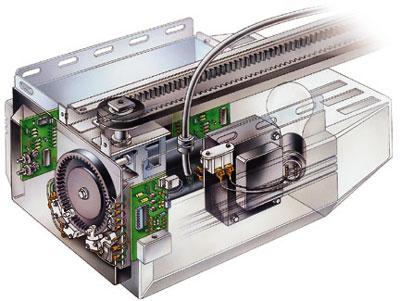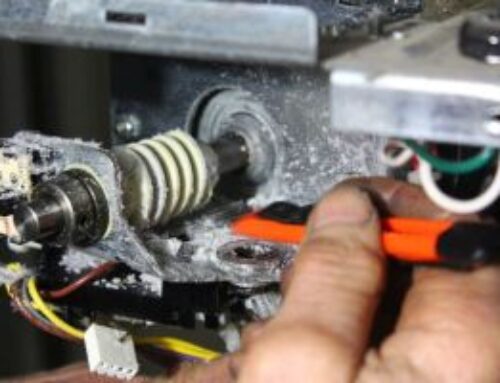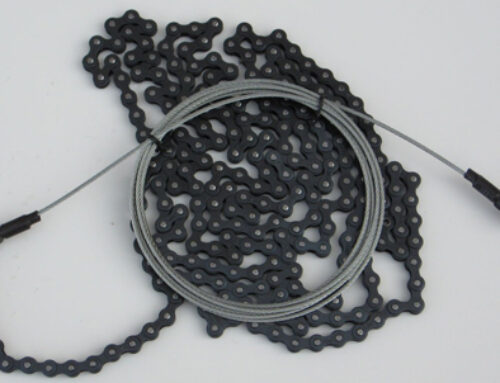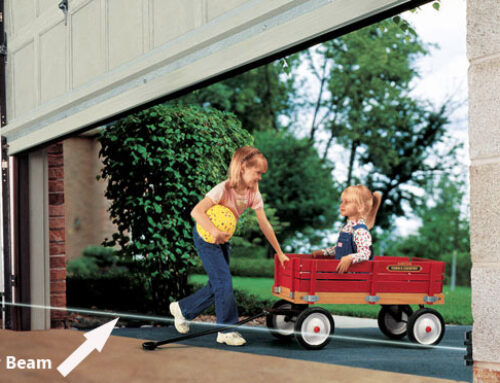This belt-drive garage door opener DIY repair guide gives step-by-step instructions for replacing the motor. The motor spins the pulley that moves the trolley along the rail to raise and lower the garage door. If the motor doesn’t work at all when activated, replace it with a manufacturer-approved replacement part.
Parts Required
- Motor
Tools Required
- Step ladder
- Socket wrench set
- Phillips screwdriver
- Slot screw driver
- Wrench set
- Channel-lock pliers
- General-purpose grease
- Work gloves
- Work table
Before you begin working make sure you wear work gloves to protect your hands.
The following steps will guide when replacing the motor on the belt.
Step 1: Disconnect power
- Use a step ladder to access the garage door opener’s power cord and motor unit.
- Unplug the garage door opener.
Step 2: Take the garage door opener down
Tip: You may want to have a helper assist you when taking the garage door opener down.
- Pull the emergency release rope to release the trolley from the garage door.
- Shut the garage door if it’s not already closed.
- Remove the fastener ring from the straight door arm connected to the outer trolley.
- Pull out the clevis pin while supporting the straight arm to disconnect the garage door from the outer trolley.
- Lower the straight and curved arms and rest them against the garage door.
- Open the light cover to access the wall control and safety sensor wires connected to the motor unit.
- Take a digital photo of the wall control and safety sensor wires connected to the motor unit. You’ll refer to the photo later when reconnecting the wires.
- Disconnect the wall control and safety sensor wires from the motor unit.
- Close the light cover.
- Remove the nuts, bolts, and lock washers that secure the motor unit to the ceiling bracket. Support the motor unit with one hand as you remove the last bolt from the ceiling bracket.
- Carefully lower the motor unit down and rest it securely on top of the step ladder.
- Climb down the step ladder and lower the motor unit down, resting the motor unit on your work table.
- Move your step ladder by the garage door so you can remove the rail from the header bracket.
- Remove the fastener ring from the header bracket clevis pin.
- Pull the clevis pin out of the rail and header bracket while supporting the rail with one hand.
- Lower the rail and rest it on a rung of the step ladder so the rail is level with the motor unit on your work table.
Step 3: Release the belt
- Slide the outer trolley away from the inner trolley.
- Loose the spring nut to relieve belt tension.
- Using channel-lock pliers carefully squeeze the spring on the spring nut and trolley shaft to create slack in the belt.
- Unhook the trolley connector from the front of the trolley and then release the spring tension.
- Remove the screws from the belt cap on the motor unit and pull the belt cap off.
- Release the belt from the motor pulley.
Warning: The spring nut is under heavy tension. Use care when compressing the spring to avoid injury.
Step 4: Remove the motor
- Remove the light covers and light bulbs from the motor unit.
- Remove the battery cover screw and then take off the battery cover.
- Pull the battery out and disconnect the battery wires.
- Remove the retainer clip from the motor pulley and pull off the motor pulley.
- Remove the screws from the motor unit cover and pull off the motor unit cover.
- Remove the motor mounting screws, supporting the motor with your hand as you remove the last screw.
- While still supporting the motor, carefully flip the motor unit over.
- Disconnect the motor wire harness from the logic board.
- Unplug the wire harness from the RPM sensor.
- Pull the motor out.
Step 5: Install the new motor
- Position the new motor in the motor unit.
- Plug in the RPM sensor wire harness.
- Plug the motor wire harness into the logic board.
- Connect the motor wire harness to the other wires inside the motor unit using a cable tie.
- While supporting the motor with one hand, carefully flip the motor unit over.
- While still supporting the motor unit, install the motor mounting screws.
- Reinstall the motor unit cover, securing it with the mounting screws.
- Install the motor pulley and secure it with the retainer clip.
- Connect the wires to the battery and insert the battery into the battery box.
- Reinstall the battery cover and secure it with the mounting screw.
- Reinstall the light bulbs and light covers
Step 6: Reinstall the belt
- Route the belt around the motor pulley and reinstall the belt cap, securing it with the mounting screws.
- Align the belt along the rail and hold the trolley connector next to the inner trolley.
- Using channel-lock pliers compress the spring on the spring nut and trolley shaft to create slack in the belt then hook the trolley connector to the front of the trolley.
- Slowly release the spring.
- Tighten the spring nut to tension the belt.
Step 7: Reinstall the garage door opener
- Reconnect the rail end to the header bracket using the clevis pin and fastener ring.
- Position your step ladder under the motor unit ceiling bracket and carefully set the motor unit on top of the step ladder.
- Climb the step ladder and reinstall the motor unit to the ceiling bracket using the nuts, bolts and lock washers.
- Open the light cover to access the wall control and safety sensor terminals on the motor unit.
- Using your digital photo for reference, reconnect the wall control and safety sensor wires to the motor unit.
- Close the light cover.
- Reconnect the straight door arm to the outer trolley using the clevis pin and fastener ring.
- Re-engage the trolley.
Tip: Reconnect the curved door arm to the straight door arm using the bolts, lock washers and nut if you disconnected the curved arm from the straight arm when freeing the garage door from the outer trolley.
Step 8: Reconnect electrical power
- Plug in the garage door opener.
Step 9: Set the travel limits
- Press and hold the black adjustment button until the up button flashes.
- Push and hold the up button until the door reaches the desired up position. Toggle the up and down buttons if necessary to achieve the desired up position.
- Press and release the black adjustment button to set the up position.
- The garage door opener lights will flash twice to indicate that the up position is set, and the down button then flash.
- Press and hold the down button until the door is in the desired down position, toggling the up and down buttons as necessary to achieve the desired down position.
- Press and release the black adjustment button.
- The garage door opener lights will flash twice and the up button will then flash.
- Press the up button and the door will move to the programmed up position. Then, the down button will flash.
- Press the down button and the door will move to the programmed down position.
- The programming is complete.
Warning:
Undertaking repairs or maintenance to appliances or power points can be hazardous. Should you choose to undertake repairs or maintenance you are assuming the risk of injury to you as a person and/or property. In an effort to reduce the risk, it’s advisable to use the proper tools and the safety equipment that are noted in the applicable guide. One must also make sure that they follow all the instructions. Do not proceed to any step until you are confident enough that you have clearly understood all the necessary steps that need to be followed in the repair or maintenance process. Some repairs and maintenance procedures should be performed by qualified technicians.
What are the advantages and disadvantages of a garage door that uses the belt drive opener?
Belt Drive Pros
- Noise – One of the things that make the process of raising and lowering your garage doors a noisy experience is the chain drive mechanism. A belt drive however nearly eliminates noise from the process which is one of the main advantages it has over the chain drive. In this regard there isn’t much of a contest. Belt drive garage doors are much quieter to operate.
- Strength – Belt drives will do a fine job of lifting practically any type of garage door. Drive belt construction has made great strides in recent decades, to the point that they’re now used on many large motorcycles; which should tell you something about their durability as well.
- Speed – Belt drive garage doors will lift an average weight door slightly quicker than their chain counterpart. So if getting into your home a few seconds faster is important to you, you’ll want to go with a belt drive system.
- Ease of Installation – Any drive mechanism whether chain or belt, is going to eventually need replacing. When that time comes replacing a worn or broken belt can be a significantly easier process than replacing a broken chain drive.
- Availability – Belt drive garage door openers are available nearly everywhere you buy home improvement products. You can also purchase them through garage door installation and service companies if you like.
- Ease of Maintenance – Belt drives do not need to be lubricated the way chain drives do.
Belt Drive Cons
- Strength – How can the same issue be both strength and a weakness? Because while belt drive garage door openers will typically lift the average 1 car garage door with quiet ease, they may struggle a bit when it comes to lifting heavier, 2 car garage doors, or for that matter heavy wooden doors.
- Performance – While belt drives will operate just fine under most conditions they may slip when operating in extreme heat or during times of very high humidity.
- Lifespan – Typically a belt will not last as long as a chain will so you’ll have to replace them more often. On the upside they usually come with a better warranty than chain drive systems.
- Price – Belt drive garage door openers will typically set you back more than chain drive openers, but, as mentioned above, they also usually come with a better warranty.






